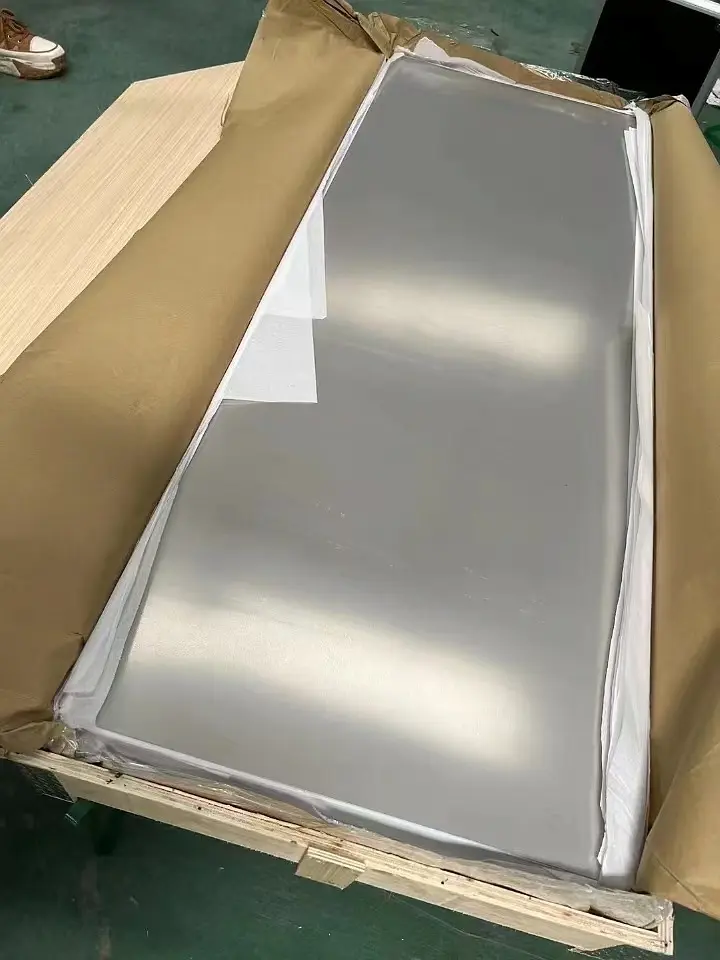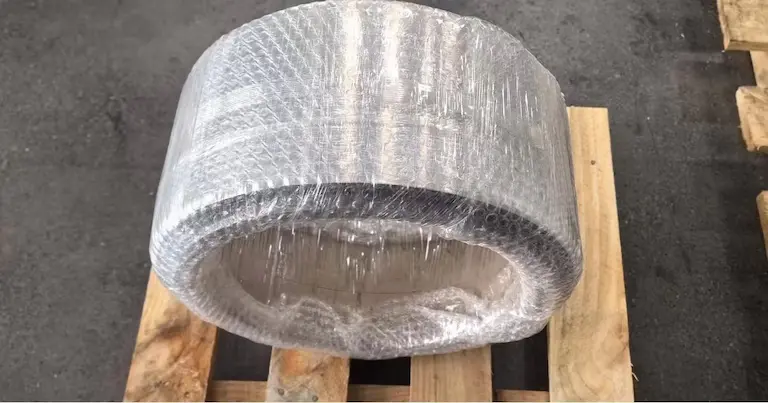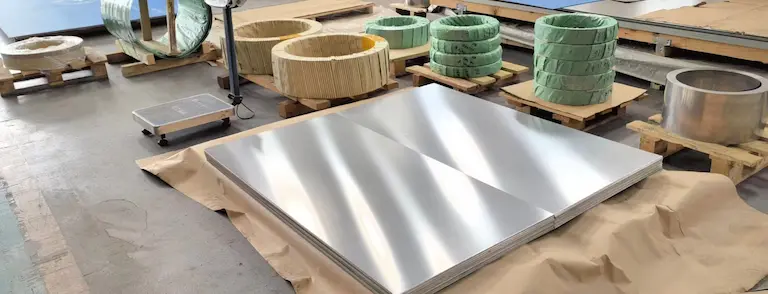Stainless Steel AISI 316Ti (S31635) By The AISI System

Ewan Liao

Myriad manufactures AISI 316Ti stainless steel with a high-strength austenitic stainless steel that is designed for primary shaping into wrought items. The properties are valid for the annealed state. The AISI nomenclature for this material is 316Ti and the UNS number is S31635.
Thus, it has the lowest tensile strength among the Yaoyi’s wrought austenitic stainless steels.
In Yaoyi’s material properties cards, the graph bars compare AISI 316Ti stainless steel to wrought austenitic stainless steels, all iron alloys, and the full database. A full bar indicates that this is the greatest value in the set. A half-full bar indicates that it is 50% of the maximum, and so on.
AISI is an American steel industry public representation and the primary material on the market is steel. AISI is also an innovative innovator in steel and steel research and implementation.
In addition, AISI is composed of members who manufacture steel, including makers of integrated and electric steel ovens, and members that supply and use steel.
On the other hand, AISI steel standards stockholders and suppliers are delivered across the United Kingdom. Iron and Steel American Institute For a number of steel models AISI standards apply, such as carbon steel, alloy steel, tool steel and stainless stainless steel. AISI steel grades are becoming increasingly popular in the UK, mainly because they are applicable to the petroleum and gas industries. The SAE designations are sometimes shortened to the AISI grades.
Material Testing After You Place An Stainless Steel Foil Order
Hardness Testing
Ingredient detection
Tensile Strength Test
Table of Contents
What is AISI 316 Ti?
AISI 316Ti is a titanium-stabilized variant of the widely used 316 austenitic stainless steel. It offers enhanced resistance to high-temperature corrosion and increased durability in aggressive environments. Titanium is added to this alloy to improve its resistance to sensitization (grain boundary carbide precipitation), a common issue in standard 316 stainless steel at elevated temperatures.
1. Chemical Composition
316Ti is similar to 316 but with the addition of titanium (typically 0.5% to 0.7%) to stabilize the structure. The composition generally includes:
- Chromium (Cr): 16%–18%
- Nickel (Ni): 10%–14%
- Molybdenum (Mo): 2%–3%
- Titanium (Ti): Stabilizer, ensuring strength and resistance to sensitization.
2. Key Properties
- Corrosion Resistance: Excellent resistance to pitting and crevice corrosion, especially in chloride-rich environments (e.g., marine and chemical processing industries).
- High-Temperature Performance: Titanium stabilization allows it to withstand prolonged exposure to temperatures between 550°C and 800°C (1022°F–1472°F) without compromising corrosion resistance.
- Mechanical Strength: Comparable to standard 316, with similar tensile and yield strength.
3. Applications
316Ti is commonly used in industries requiring durability, resistance to corrosion, and performance at high temperatures, such as:
- Chemical processing equipment
- Heat exchangers
- Piping and tanks in marine environments
- Pharmaceutical equipment
- Food processing industries, particularly for acidic foods
4. Advantages of Titanium Stabilization
- Titanium prevents the formation of chromium carbides at grain boundaries during high-temperature welding or heat exposure, reducing the risk of intergranular corrosion.
- Enhanced long-term strength in high-temperature applications compared to 316.
Stainless steel Yaoyi’s 316Ti has titanium trace quantities. The concentrations of titanium are usually less than 0.5%. Titanium atoms balance structure 316 at temperatures higher than 800 ° C. This prevents precipitation of carbide on grain frontiers and protects against corrosion of the metal.
Yaoyi 316Ti’s principal benefit is its sensitivity resistance for a prolonged period of time at high temperatures. 316Ti, 316 has a comparable standard physical and mechanical quality.
J2 Stainless Steel: A Complete & Thorough Guide
AISI 316Ti: Heat Resistance
In a variety of tough situations, Yaoyi’s AISI316Ti has a great resistance to corrosion. AISI 316Ti (1.4571, UNS S31635) is a standard stainless steel that is not resistant to hot sea water but is thought to be marine. In the conditions of heated chloride, cracks and crevices may form.
AISI 316Ti: Heat Resistance

The aisi 316Ti of Yaoyi has a high oxidation resistant to 870°C and 925°C in constant use. On the other hand, it is not recommended for continued use at 425-860° C if water is required to resist corrosion. Due to excellent carbide precipitation resistance, 316L is proposed in this scenario. Class 316H is recommended for temperatures above 500 ° C.
In addition, Yaoyi’s aisi 316Ti (UNS S31635) is an austenitic stainless steel 316 molybdenum titanium-stabilized variant. The 316 allegations are stronger than the traditional austenitic chromium nickel stainless steels like 304 to prevent general corrosion and corrosion by the pitting/crevice.
Furthermore, at greater temperatures, they have an increased creep, stress breakdown and tensile strength. High carbon Aisi 316 stainless steel can produce sensitizing chromium carbid grain boundaries, which may lead to intergranular corrosion at temperatures between 900 and 1500°F (425 to 815°C).
AISI 316Ti: Sensitisation
Yaoyi’s Aisi 316Ti is sensitivity resistant due to the addition of titanium, the source of sensitisation, which stabilizes the chromium carbide precipitation structure. This stabilization is carried out through an intermediate temperature heat treatment where titanium combines with carbon to produce titanium carbide. Yaoyi’s aisi 316Ti processing significantly reduces the sensitivity to sensitation in service, by reducing the production of chromium carbides.
The alloy can therefore be used at higher temperatures without impairing their corrosion resistance for extended periods. Yaoyi’s aisi 316Ti has equal sensitivity corrosion resistance to the low carbon form of 316L.
AISI 316Ti: General Properties
Yaoyi aisi 316Ti (UNS S31635) is an austenitic stainless steel titanium-stabilized variant. DIN/EN 1.4571 is also known. In comparison with the standard chromium nickel austenitic stainless steels such as Type 304, AISI 316 offers improved resistance to general corrosion, pitting and crevice corrosion.
Furthermore, at higher temperatures they show increased creep, stress rupture and tensile strength. Yaoyi’s aisi 316 stainless steel is sensitized when chromium carbides, bounded by grains, develop from around 900 to 1 500°F (425 to 815°C), which results in rapid corrosion. Sensitization is not a concern with decreased carbon type 316L but will eventually lead to sensitization if exposure to this temperatures is sustained.
How To Find The Right Stainless Steel Supplier – YAOYI Stainless Steel
AISI 316Ti: Specifications
ASTM A 240 specifies 316Ti for plate, sheet, and as well as strip items.
Units of Property Value
●Density at 72 degrees Fahrenheit (22 degrees Celsius)
●Thermal Conductivity at 212 degrees Fahrenheit (100 degrees Celsius)
●Thermal expansion coefficient between 68 and 212 degrees Fahrenheit (20 and 100 degrees Celsius)
Grade 304 Stainless Steel Foil– YAOYI Stainless Steel
AISI 316Ti: Resistance to Fatigue
The maximum stress is the fatigue strength or endurance limit of a material and it is unlikely to fail in ten million air cycles. In general, the fatigue strength of austenitic stainless steels is around 35% of the strength of the tensile. However, considerable diversity in the outcomes of service is attributable to the influence on fatigue properties of additional variables, such as corrosive conditions, load type and average stress and the surface condition.
As a result, no precise endurance limit value that is indicative of all working situations can be offered.
At all temperatures up to the melting point, Yaoyi’s aisi 316Ti is a single phase austenitic or face centered cubic stainless steel. Heat treatment cannot be used to harden the alloy. In its annealed state, the alloy is nonmagnetic. At 200 H, its magnetic permeability is frequently less than 1.02. (Oersteds).
Thus, the permeability of the cool deformed material vary by composition and cold deformation level, but typically exceeds the permeability values of the annealed material.
AISI 316Ti: Resistance to Oxidation
Yaoyi’s aisi 316Ti stainless steel has remarkable oxidation resistance and low rate of scaling with temperatures ranging from 1600-1650°F (870-900°C).
The performance is therefore significantly lower than the performance of stainless steel of type 304, aisi 316Ti, which includes slightly more chrome (18 percent vs. 16 percent ). Service environment and operational circumstances are extensively controlled at the oxidation rate. Therefore, no universally applicable statistics can be supplied.
As with other molybdenum-containing alloys, aisi 316 Ti in Yaoyi is prone to catastrophical oxidation in stagnant air conditions at elevated temperatures, for example in densely packaged products during heat treatment. This results from the production of a low melting point of molybdenum trioxide (MoO3)
ASTM A240 Type 304: Properties, Pricing, and Applications – YAOYI
AISI 316Ti: Corrosion Resistance
Molybdenum-containing inoxidated steels, such as aisi 316 and 316Ti from Yaoyi are more airtight than stainless steels from 18Cr-8Ni.
Broadly specified medium will not be affected by 18–8 stainless steels.
Yaoyi aisi 316 and 316Ti are considerably stronger than any chromium-nickel alloy, resistant to sulfuric acid solutions. These alloys are far more resistant to the condensation of sulfur-containing vapors than other shapes of steel. Sulfuric acid solutions,
The acid concentration affects the attack rate significantly.
AISI 316Ti: Corrosion Pitting
The increase in Yaoyi Chromium (Cr) and Molybdenum (Mo) content enhances the resilience of austinless stainless steels in presence of chloride or other halide ions against pitting and/or crevice corrosion. A relative measure of pitting strength is presented by the PRE or Pitting Resistance Index.
The PRE of aisi 316 Ti (23.0) of Yaoyi is larger than the PRE of type 304 (PRE =19.0), which indicates that the resistance to pitting of type 316Ti is higher due to its Mo content. In waters containing up to roughly 100 parts per million of chloride, Stainless Steel type 304 is considered resistant to tearing and crevice corrosion.
On the other hand, Yaoyi’s aisi 316Ti alloy, due to its molybdenum presence, can withstand chloride concentrations of up to around 2000 parts per million.
ASTM A167: Composition, Properties, and Equivalent Grades – YAOYI
AISI 316Ti: Corrosion Between Granules
If the temperature of the Yaoyi 316Ti stainless steel ranges between 800°F and 1500°F (425°C – 815°C), it is sensitive to chrome carbide precipitation on the grain borders.
Surprisingly, when exposed to harsh conditions, these sensitized steels are prone to intergranular corrosion. To eliminate the risk of intergranular corrosion, Yaoyi’s 316L stainless steel is provided. Type 316L is resistant to intergranular assault even after brief periods of exposure to a temperature range of 800-1500°F (425-815°C).
Within these parameters, stress relieving procedures can be used without impairing the metal’s corrosion resistance. Accelerated cooling from elevated temperatures is not required for the Lî grades when particularly large or heavy sections have been annealed.
Yaoyi’s 316Ti is more resistant to intergranular corrosion than its higher carbon equivalent, Type 316. Although transient heat during soldering or stress reductions does not lead to intergrain corrosion susceptibility, constant or prolonged exposure to temperatures between 800°F and 1200°F (422° to 650°C) might lead to sensitization.
AISI 316Ti: Intergranular Corrosion
Stabilized austenitic stainless steels like aisi 316Ti can be attacked by inter-granular corrosion under certain unique welding conditions. One of these conditions is knifeline attack. The region of severe corrosion is quite thin directly near the weld. It occurs when the metal near the solder is heated to a high (greater than 2100 degrees F) temperature and subsequently subjected to a sensitization (800°1500 degrees F; 425 degrees C 815 degrees C). At these temperatures, titanium carbides grow slowly, and the free carbon combines chromium in a heat affected zone to make grain limits carbides.
Best AISI 321 stainless steel products are available- YAOYI Stainless Steel
AISI 316Ti: Oxidation
The combined effects of molybdenum and titanium lower Yaoyi’s aisi 316Ti stainless steel’s resistance to highly oxidizing environments, such as the nitric acid environment used in the ferric sulfate environment.
AISI 316Ti: Stress Corrosion
Atenitic stainless steels are prone in halide circumstances to crack stress corrosion (SCC). While Yaoyi’s aisi 316, 316L, and 316Ti have more SCC resistance than 18 Cr-8 Ni alloys, they are nevertheless very sensitive. The following situations produce SCC: The following:
(1) The halide ion is present (generally chloride),
(2) Persistent tensile tensions,
(3) Temperatures greater than around 140°F (60°C).
Stresses are generated during welding by cold deformation or thermal cycling. Annealing or stress-relieving heat treatments may be useful at reducing stressors and thus the sensitivity to halide SCC. While stable aisi 316Ti and low carbon Lî grades are available at Yaoyi.
While they offer no advantage in terms of SCC resistance, they are preferable for service in stress alleviated conditions in settings prone to intergranular corrosion.
Manufacturing AISI 316Ti
Fabrication
Austenitic stain-less Steels are commonly made in a variety of shapes from the simplest and most intricate, especially Yaoyi’s aisi 316Ti stainless steel. The alloys are blank, pierced and formed with machinery similar to that for carbon steel. Due to the remarkable ductility of austenititic alloys, bending, stretching, deep drawing and spinning can be easily produced.
However, the austenitic grades demand substantially more power during forming operations than carbon stains due of their enhanced strength and work hardenabilities. Lubrication is essential to accommodate their high strength and bile propensity during the production of austenitic alloys.
Annealing
Yaoyi provides the austenitic aisi 316Ti in their mill-glued condition, and they may be used immediately. Due to cold forming effects or precipitate chromium carbide generated by thermal exposures, heat treatment may be necessary during or following the production process.
The solution of annealing the Yaoyi 316Ti Alloy is also achieved by heating to a 1900-2150 °F (1040-1175 °C) temperature range followed by air or water tubing, depending on the thickness of the piece. Aisi 316Ti should be stabilizarized about 1550-1650°F (845-900°C) in order to maximize sensitization resistance to precipitate titanium carbides and to prevent precipitation of chromium carbides at low temperature. Heat treatment for hardening type 316Ti cannot be applied.
Welding
Austenitic stainless steels are the most weldable type of stainless steel. All fusion and resistance welding methods are frequently used to link them. Two critical factors to consider while welding aisi 316Ti are:
(1) averting the formation of solidification cracks,
(2) maintenance of the weld and heat-affected zone’s corrosion resistance.
Stainless steel Yaoyi’s 316Ti aisi is often welded independently. Where welding is required, low carbon filler metals of the 316L or E318 type are preferred. Contamination of copper or zinc of the sold zone should be avoided as these metals may produce compounds with low melting point which may lead to soil cracking.
Applications of AISI 316Ti (1.4571, UNS S31635)
The following areas are frequently used for stainless steel AISI 316Ti (1.4571, UNS S31635):
●Food Processing Equipment Machinery for brewing
●Chemical and petrochemical industry equipment
●Laboratory equipment and benches
●Beach, coastal and boat decks
●Chemical containers
●Heat exchangers and mining screens
●Bolts and nuts
●Springs
●Medical implants made of inoxidable steel.
What is the difference between 316L and 316Ti?
In a sense, titanium can be included in austenitic steels with a higher carbon content to reduce the growth of chromium carbides as a stabilizing element. It thereby strengthens the resistance to aqueous corrosion on the welding parts of stainless steel grades with a higher carbon content.
Though these two grades, 316L and 316Ti, are sometimes used interchangeably, they are not perfect alternatives for one another. Indeed, Yaoyi’s 316Ti outperforms 316L in terms of pitting resistance, tensile strength, and yield strength. 316Ti is required for particular tools and equipment that are subjected to a high acid corrosion environment, such as pickling tanks and support frames.
| Property | AISI 316 | AISI 316Ti |
| Stabilizing Element | None | Titanium (0.5%–0.7%) |
| Sensitization | Susceptible at 550°C–800°C | Resistant due to stabilization |
| High-Temperature Use | Limited | Excellent |
| Applications | General-purpose | High-temperature, critical environments |
316Ti is essentially a high-performance version of 316, ideal for applications where long-term exposure to heat and aggressive environments is a concern.
General Specifications of AISI 316Ti (1.4571, UNS S31635)

The stainless steel grades of Yaoyi 1,4401 and 1,4404 are also known as 316 and 316L. The grade 316 is an important commercial variation of the grade 304 austenitic. To increase corrosion resistance, Molybdenum is added to 316 stainless steel. This resistance is particularly common in the context of chloride pitting and crevice corrosion.
316L is, in addition, a 316 stainless steel, low carbon variant with a grain limit that withstands carbide precipitation or sensitization. This is excellent for use in large soldered parts with a diameter of above 6 mm like Yaoyi produces.
For high-temperature applications you can select a highly carbon variant, like stainless steel 316H or stabilized stainless steel 316Ti. Even at freezing temperatures, the atenitic structure of 316 steel gives extraordinary endurance.
What Exactly Is AISI Steel?
A class of iron-carbon alloys known as stainless steels, these materials combine the mechanical properties of steel with exceptional corrosion resistance, particularly when exposed to moist air or fresh water.
The inclusion of other elements, especially chromium, in the alloy contributes to the corrosion resistance of the alloy. In order to protect the metal or alloy from the action of external chemical agents, these elements cover the substance with a thin, adhesive, and virtually undetectable layer that is thin, adherent, and nearly invisible.
The Coding System’s Origins
In the early 1940s, a method of encoding was designed to classify various steel grades. Detailed information may be gathered from developers, heat treatment companies, draftsmen and engineers regarding steel types and grades. Its efficiency is seen in the steel rating, because it is based on the requirements of the American Iron and Steel Institute (A.I.S.I) (S.A.E.).
For a lot of years, alloy stones and carbon stones were classified using the four-digit SAE and AISI numerical index system. The system defined classes for alloy steels and carbon steels based on its typical chemical compositions. AISI’s choice not to compose material standards resulted in an infringement of the relationship between grades and AISI.
Classification of AISI Materials
The SAE method is used to indicate the chemical composition of alloys and carbon stones using a simple four digit format. AISI ratings could be renamed SAE ratings and in the AISI and SAE regulations the same identification number commonly appears. For AISI alloy stones and carbon steels, often a four-digit number is designated. The two initial numbers show the alloy element, while the other two numbers show the amount of carbon.
Keep reading:A complete guide to SUS 304 stainless steel
The Schematic AISI/SAE Steel Designation System
The specifications of Yaoyi AISI steel include stainless steels as well as other types of steel. For inox steels, three-digit identif iers beginning with the numbers 2, 3, 4, or 5 are used to identify them. The 300 austenitic grades of stainless steel and the 400 martensitic grades of stainless steel are the stainless steel grades that are most frequently determined in the industry.
The SAE/AISI Steel Numbering System
The first edition of the AISI/SAE steel designation shows a comprehensive classification of steels. This indicates that carbon steels are the 1xxx groups in the system SAE-AISI. The variations in important basic characteristics of carbon stainless steels are divided into four classes.
The number of the second series demonstrates the existence of important components capable of affecting steel characteristics. For instance, the zero of the 10XX series denotes the lack of significant secondary elements in steel such as sulfur. For example, although sulphur in steel promotes machinability, no machine agents, such as sulphur, plum, calcium and others are either environmentally or directly withdrawn. Such loose processing portions may not fully homogenize during steel production processes, and could lead to threads, sackcloths or other faults that impact Steel’s properties.
Therefore, certain code groups such as 11L41, 12L14 or 50B40 can sometimes place additional letters between the second and third numbers. Letter L refers to the use of plumbing to improve the machining of steel (between 0.15% and 0.35%). The letter B refers to the use of low carbon boron stones in order to enhance the hardness of the steel (between 0,0005% and 0,003%).
Get it now:A Complete Guide to SUS Stainless Steel Banding
AISI Steel: Components
AISI Steel’s final two digits denote a carbon content of 0.01 percent. SAE 1018 refers to carbon steel that has not been changed and has 0.18 percent carbon. SAE 5130 refers to a chrome alloy steel containing 1% chromium and 0.3% carbon.
Simple carbon stones with a maximum content of 1,00% are, for example, divided into 10xx series, fur-proof carbon steels are divided into 11xx series, results and rephosphorized carbon stones are divided into series 12xx and non resulfurized, highly manganese carbon stores with a maximum content of 1,65% are divided into 15xx series For example, Carbon steels with high concentrations of manganese but not sulfur were developed to increase machinability.
Merchant quality AISI steels, such as Yaoyi’s AISI steels, which are utilized as hot-rolled steel bars in the fabrication of non-critical elements of machines and structures, are preceded with the letter M. alloy steels with the prefix E denote steel produced in an electric furnace, whereas alloy steels with the suffix H denote steel that has been created to meet the required hardenability limits.
The American Iron and Steel Institute (AISI) has amended a total of six standards for cold-shaped steel (CFS). The American National Standards Institute has recognized AISI as a consultative body accredited by the American National Standards Institute to create American National Standards.
Properties
An alloy of malleable iron and carbon, Yaoyi’s AISI steel has between 0.10 and 2 percent carbon, which has an impact on the steel’s hardenability. When combined with other metals, such as manganese, molybdenum, chromium, or nickel, it can be used to improve hardenability and other qualities, such as corrosion resistance.
Cast irons, which are made of iron and carbon alloys containing more than 2 percent carbon, are not flexible, with the exception of particular varieties known as malleable and ductile cast iron. They can be shaped and sized to fit a range of needs and requirements.
In comparison to other materials such as wood, plastics, or ceramics, Yaoyi’s aisi steel has a high strength, is resistant to fatigue and impact, and has good creep resistance. It is also electrically and thermally conductive; heavy; temperature resistant; and reasonably hard. Steel is produced by heating pig iron to a high temperature and purifying it.
Read more about A Complete Guide to SUS Stainless Steel Banding
Steels are classified into the following categories:
- Carbon Steel in its natural state
- Steel Alloy
- Steel with Low Alloy Content
- Surgical Stainless Steel
Plain Carbon Steel
Because simple carbon steel is free of other alloying materials than carbon, its carbon content is split into three categories: low carbon, medium-carbon and high carbon. In the manufacture of rivets and refrigerated parts such as wires, stampings and other similar products in the lower ranges, the manufacturing team of Yaoyi uses low-carbon (0.3% carbon) steel; the engineering and manufacturing employees of the company use structural forms, gear, cold-forged and soft tubes in middle- and upper range.
Medium Carbon Steel
Medium-carbon steel (0.3-0.5 percent carbon) is frequently known as a stainless steel machine, as it is used, among other things, to make gears, shafts, rods and seamless tubings. The type of steel utilized for a number of applications, including springs, blades and hand tools, taps and friction cutters, wire-design plugs and many others, is carbon steel (with carbon content greater than 0.5%). You can use Yaoyi to provide what is often called steel or spring steel.
Try for free information about the A Complete Guide to Stainless Steel AISI 420
Simple Carbon Steel
The AISI four digit classification method classifies ordinary carbon steel as 10xx, which are the final numbers indicating the quantity of carbon present in the metal. A simple mild carbon steel made in Yaoyi, using the example of 1010, has 0.08-0.13% carbon. 11xx is a steel designation which can be machined freely.
Steel with Low Alloy Content
This is occasionally referred to as HSLA steel, or High-Strength Low-Alloy steel, this metal has greater strength than ordinary carbon steels and is employed in applications where weight is a consideration, such as mobile equipment. Yaoyi ensures that aisi steel cold forms well and welds easily. It is more corrosion resistant than plain steel and also has superior impact, fatigue, and abrasion resistance.
Ship-hull and off-road engineering use other low-alloy steels, like HY 80 and HWY 90. Specific uses include the production of low temperature robustness covers in building facades on ornamental steel. For some applications, other low alloy steels are available.
Keep reading: A Complete Guide to Stainless Steel AISI 4140
Surgical Stainless Steel
Aisi Steel of Yaoyi is an iron/chromatic alloy that contains 10 to 30% chromium, which gives the metal a great corrosion resistance. Although various stainless steel grades exist, only around a dozen are consistently used.
Yaoyi’s stainless steels, type 304 AISI, which contain chromium and nickel and are low in carbon, for instance, are popular due to their resistance to corrosion and cleanliness.
Type 316 AISI is chemically more resistant to sea, salt, sulfuric acid and other corrosive agents than Type 304, which is suitable for exposure in an industrial setting.
AISI Steel: Hardening
To harden simple carbon steel, the material must be rapidly chilled. This can result in excessive residual stresses, deformation, and decreased ductility, among other problems.
Hardenability refers, in that criterion, to the depth at which a steel is hardened, and alloy steels fall into around two camps: carbohydrate stones that harden mostly on the surface and harding stones that can harden the core of the metal.
Although the carbon content of steel governs its strength, certain alloying elements used in steel can reduce trauma in thin-walled products in order to reduce the distortion of squirting.
Manganese is marked 13xx in Yaoyi, 2xxx in nickel steels, 3xxx in nickel chromium steels, 4Xxx in molybdenum steels and 9xxx in silicon manganese stalks.
Edges can generally be hardened in oil for slower quenching than plain carbon steels. Yaoyi producers ensure that distortion can be reduced and a deeper harding of the material core is allowed.
Read on:AISI 430 Stainless Steel
